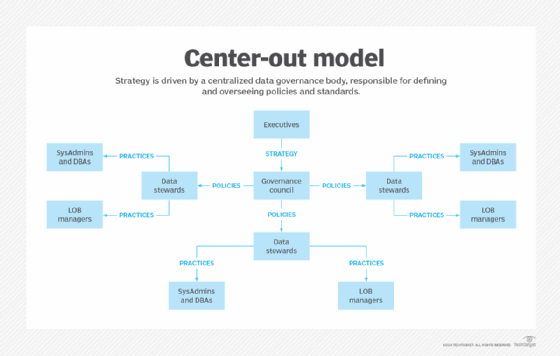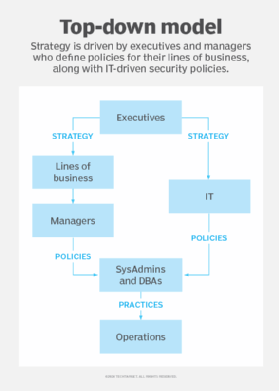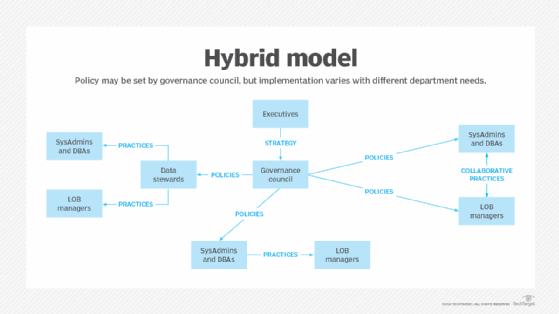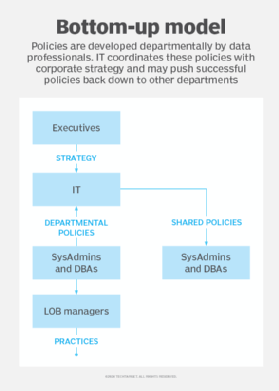
Yuichiro Chino/Moment via Getty
5 data governance framework examples
Data governance isn't plug and play: Organizations must select which data governance framework best fits their business goals and needs.
Organizations that treat their data as an asset have a data governance framework that matches their style, structure and culture.
Organizations of all sizes collect, store and process data from numerous sources, including customers, employees and business partners. Without proper oversight, they can miss valuable insights, violate privacy regulations and make decisions based on inaccurate or incomplete information. They might encounter other data issues such as inconsistencies, errors and duplications.
A data governance framework provides a structured, consistent approach to manage data assets and treat data as a valuable resource that supports business strategy. Data governance frameworks consist of policies, processes and standards that define how to collect, store, use and protect data throughout its lifecycle.
Establishing guidelines and best practices through a data governance framework helps organizations ensure regulatory compliance, improve data quality and develop transparent data management practices. A practical framework gives data users confidence in data reporting, analysis and planning. By demonstrating a commitment to responsible data management, organizations can build trust among their stakeholders, including customers, partners and regulators.
Pillars of a data governance framework
An effective data governance framework is built on four essential pillars: data quality, data security and privacy, data ownership and accountability, and data governance metrics.
Data quality
Data quality measures whether the data fits its intended purpose. High-quality data is accurate, complete, consistent and timely. It is the core of any data initiative.
A governance framework needs four essential procedures to establish and maintain good-quality data:
- Regular profiling to assess data and identify quality issues.
- Cleansing and validating to remove errors and inconsistencies.
- Defining data quality metrics to measure and monitor quality over time.
- Implementing data quality controls throughout the data lifecycle.
Data security and privacy
Organizations are susceptible to a wide range of security issues. IT teams might need a better handle on where their vulnerabilities lie. Organizations should ensure their data governance framework includes security and privacy measures to safeguard their data assets and comply with relevant regulations, such as GDPR and CCPA. A strong governance framework contains several elements to regulate data access and usage by members of the organization:
- Implement strong access controls and authentication mechanisms.
- Encrypt sensitive data at rest and as it moves around the network.
- Monitor data access and usage to detect and prevent unauthorized activities.
- Develop and enforce data privacy policies and procedures.
- Conduct security audits and risk assessments to identify and address vulnerabilities.
Data ownership and accountability
Clear ownership and accountability ensures consistent and responsible data management throughout the data lifecycle. Well-defined data ownership and stewardship roles can prevent data silos, inconsistencies and errors that occur from uncoordinated or unassigned data management. A framework should support key aspects of accountability:
- Establish data owners and stewards responsible for disparate data domains or assets.
- Define transparent processes for data access, modification and sharing.
- Create a data governance council or committee to oversee data governance initiatives.
- Promote a culture of data responsibility and collaboration across the organization.
Data governance metrics
Measuring the effectiveness of data governance initiatives enables continuous management and demonstrates the value of data governance to stakeholders. Organizations should define key performance indicators or metrics to track the progress of their data governance efforts:
- Develop dashboards and reports to monitor data quality, security and usage.
- Track the adoption and compliance with data governance policies and standards.
- Measure the relationship of data governance to business objectives.
Data governance framework examples
Organizations can adopt various approaches when implementing a data governance framework depending on their specific needs, structure and culture. Organizations should consider five standard data governance framework models.
Center-out model
The center-out model establishes a centralized data governance body, such as a data governance council or committee. They define and oversee governance policies and standards. The model balances enterprise-wide consistency with some flexibility for individual business units' specific needs. It also promotes collaboration and communication between the central governance team and data stakeholders.

The Data Governance Institute's Data Governance Framework is a center-out model that emphasizes establishing a Data Governance Office and Board. The framework comprises 10 critical components that address the rules, people, organizational bodies and processes required for effective data governance. The components include defining the mission and vision, establishing goals and metrics, identifying data rules and definitions, assigning decision rights and accountabilities, and implementing controls. The framework also emphasizes the importance of data stakeholders and assigns data stewards to ensure the program's success. It has hybrid flexibility for business units and data domains, but the Data Governance Office remains critical.
PwC, one of the world's largest professional services networks, also recommends a centralized approach to meet compliance requirements and avoid business risks. However, PwC sees it as a step to help organizations better monetize their data assets. The PwC model emphasizes a centralized data governance program for consistency across business lines and to reduce the risk of data silos and missed opportunities.

Top-down model
In the top-down model, executive leadership and senior management drive data governance. The approach ensures that governance initiatives align with the organization's strategic goals and priorities. It also provides the necessary authority and resources to enforce policies and standards across the enterprise. However, it might require more support from business units and stakeholders that feel disconnected from the governance process.
The global management consulting firm McKinsey describes a framework for effective governance that focuses on creating business value and enabling digital and analytics initiatives. The framework's key elements involve securing top management's attention and buy-in for data governance and integrating data governance with primary business transformation themes. McKinsey's model proposes a central data management office, but emphasizes that executive leadership reinforces a solid top-down process.
Hybrid model
The hybrid approach combines concepts from other models to create a customized strategy that suits the organization's unique needs and structure. For example, an organization might establish a central data governance council to set enterprise-wide policies and standards. They can also empower business units to implement local governance practices aligned with the central framework. It offers the benefits of centralized control and decentralized flexibility.
The Eckerson Group's Modern Data Governance Framework is a hybrid model. It combines elements of centralized governance through methods, processes and technology with decentralized flexibility with an emphasis on people, culture and the need to adapt to the specific requirements of different stakeholders. The framework stresses the importance of involving a wide range of people, from sponsors and owners to stewards, curators, coaches and consumers. The goal is to build a roadmap for governance as a living document, that is revisited regularly to adapt to changes in priorities or needs.

Bottom-up model
The bottom-up model involves data stakeholders and subject matter experts from across the organization in the governance process. The model encourages collaboration and buy-in from people closest to the data, which ensures that governance policies and procedures are practical, relevant and effective.

DAMA, a well-known community of data management professionals, developed the Data Management Body of Knowledge (DMBOK). The comprehensive model defines the standard functions and activities related to data management within an organization. Its functions cover the entire data lifecycle, including planning, architecture, development, operations and quality management.
The DAMA-DMBOK framework is flexible, but it's commonly used as a bottom-up approach because DAMA members typically drive initiatives from the IT department. Over time, they gain executive support and a more formalized adoption as stakeholders can show their success.
Silo-in model
A silo-in allows individual business units or departments to establish data governance practices and standards for their specific needs and requirements.
However, it can lead to inconsistency, duplication of effort and a lack of enterprise-wide coordination. The model suits organizations with highly independent business units or limited enterprise-wide data integration needs.
Few consulting firms or software vendors recommend the silo-in model because data silos are seen as problematic for governance. In practice, many data governance programs start tentatively in isolated business units that have problems to deal with or data that is especially valuable or vulnerable.
When organizations do not adopt a formal data governance framework, they often default to a silo-in approach due to practical considerations. Business units may recognize the need for governance within their domain and take the initiative to establish practices and standards that address their specific pain points or opportunities. The factors that drive the need for governance within the specific unit can include the following:
- Regulatory compliance requirements that apply to specific business units or data domains.
- The need to improve data quality and consistency within a particular business function.
- The desire to use data assets for competitive advantage or innovation within a specific market or product line.
Localized efforts can deliver benefits within their limited scope, but they often need to consider the broader enterprise context and can create challenges down the line. As the organization matures and seeks to use data assets holistically, siloed governance practices can become barriers to integration, interoperability and scale.
If a silo-in approach emerges as the starting point for data governance in an organization, it is essential to recognize its limitations and plan for a transition to a more enterprise-wide model over time:
- Identify and prioritize data domains that cut across business units and require a more coordinated approach to governance.
- Establish cross-functional data governance bodies and processes to align practices and standards across the organization.
- Develop and communicate a shared vision and roadmap for data governance that balances local needs with enterprise goals.
- Invest in data integration and master data management capabilities to break down silos and enable data sharing and collaboration.
Choosing a framework
Treating data as an asset involves giving it the same care and maintenance that the most valued corporate assets receive. Implementing a data governance framework requires more than technical effort. The cultural element around ownership and accountability requires consideration of an organization's unique needs, structure and ethos.
The keys to success for any of the five models is involving the necessary stakeholders, securing executive buy-in for more comprehensive programs and developing a continuous improvement process. A data governance framework should integrate with the organization's overall business strategy, ensuring that data management aligns with goals and objectives.
Donald Farmer is principal of TreeHive Strategy and advises software vendors, enterprises and investors on data and advanced analytics strategies. He has worked on some of the leading data technologies in the market and previously led design and innovation teams at Microsoft and Qlik.







